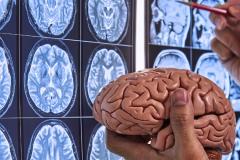- Overview
-
As a pediatric Neuropathologist, I am charged with the diagnosis and study of diseases of the nervous system in children. I examine abnormal tissues that are sampled from patients undergoing surgery or autopsy. These clinically derived tissues form the basis of my laboratory based practice and largely guide my research. Chiefly via microscopy, I am able to distinguish the culprit disease process(es) that is(are) affecting a patient; in turn, this information is then relayed to the primary care clinicians (eg, neurologists, neurosurgeons, oncologists etc.) and used to guide patient care.
One form of brain cancer has particularly captured my attention: Atypical Teratoid Rhabdoid Tumor (ATRT). My research into ATRT is aimed at re-examining BCCH’s experience with this tumor and using this information to guide the treatment of future patients. In addition, in a BCCH Telethon funded project, I am investigating the microscopy and genetics of Anencephaly, most common congenital brain malformation which is considered to reside amongst the ‘neural tube disorders’.
- Publications
-
Phenotypic evolution of UNC80 loss of function.
Valkanas E and Schaffer K and Dunham C and Maduro V and du Souich C and Rupps R and Adams DR and Baradaran-Heravi A and Flynn E and Malicdan MC and Gahl WA and Toro C and Boerkoel CF
PubMed: 27513830
08/2016Therapeutic Impact of Cytoreductive Surgery and Irradiation of Posterior Fossa Ependymoma in the Molecular Era: A Retrospective Multicohort Analysis.
Ramaswamy V and Hielscher T and Mack SC and Lassaletta A and Lin T and Pajtler KW and Jones DT and Luu B and Cavalli FM and Aldape K and Remke M and Mynarek M and Rutkowski S and Gururangan S and McLendon RE and Lipp ES and Dunham C and Hukin J and Eisenstat DD and Fulton D
DOI: 10.1200/jco.2015.65.7825
PubMed: 27269943
07/2016Histopathology of the filum terminale in children with and without tethered cord syndrome with attention to the elastic tissue within the filum.
Hendson G and Dunham C and Steinbok P
PubMed: 27236780
05/2016Uncommon pediatric tumors of the posterior fossa: pathologic and molecular features.
Dunham C
DOI: 10.1007/s00381-015-2735-1
PubMed: 26351226
10/2015Assessing the accuracy of death records and pre-mortem clinical diagnoses in children diagnosed with brain tumors: A retrospective chart review of children in British Columbia, Canada.
Hasan H and Hendson G and Howard AF and Hukin J and Dunham C and Ahmed T and Lo AC and Goddard K
DOI: 10.1016/j.prp.2015.06.008
PubMed: 26342938
10/2015Radiological features of infantile glioblastoma and desmoplastic infantile tumors: British Columbia's Children's Hospital experience.
Bader A and Heran M and Dunham C and Steinbok P
DOI: 10.3171/2014.10.peds13634
PubMed: 25955808
08/2015Molecular subgroups of atypical teratoid rhabdoid tumours in children: an integrated genomic and clinicopathological analysis.
Torchia J and Picard D and Lafay-Cousin L and Hawkins CE and Kim SK and Letourneau L and Ra YS and Ho KC and Chan TS and Sin-Chan P and Dunham CP and Yip S and Ng HK and Lu JQ and Albrecht S and Pimentel J and Chan JA and Somers GR and Zielenska M and Faria CC
DOI: 10.1016/s1470-2045(15)70114-2
PubMed: 25882982
05/2015EZH2 expression is a prognostic factor in childhood intracranial ependymoma: a Canadian Pediatric Brain Tumor Consortium study.
Li AM and Dunham C and Tabori U and Carret AS and McNeely PD and Johnston D and Lafay-Cousin L and Wilson B and Eisenstat DD and Jabado N and Zelcer S and Silva M and Scheinemann K and Fryer C and Hendson G and Fotovati A and Hawkins C and Yip S and Dunn SE and Hukin J
DOI: 10.1002/cncr.29198
PubMed: 25586788
05/2015The role of resection alone in select children with intracranial ependymoma: the Canadian Pediatric Brain Tumour Consortium experience.
Ailon T and Dunham C and Carret AS and Tabori U and Mcneely PD and Zelcer S and Wilson B and Lafay-Cousin L and Johnston D and Eisenstat DD and Silva M and Jabado N and Goddard KJ and Fryer C and Hendson G and Hawkins C and Dunn S and Yip S and Singhal A and Hukin J
DOI: 10.1007/s00381-014-2575-4
PubMed: 25391979
01/2015Evolution of a Pediatric Primary Cerebral ALK-1-Positive Anaplastic Large Cell Lymphoma on Serial MRI.
Dunbar MJ and Singhal A and Rassekh SR and Dunham C
DOI: 10.1159/000380769
PubMed: 25896198
2015Fatal congenital hypertrophic cardiomyopathy and a pancreatic nodule morphologically identical to focal lesion of congenital hyperinsulinism in an infant with costello syndrome: case report and review of the literature.
Sheffield BS and Yip S and Ruchelli ED and Dunham CP and Sherwin E and Brooks PA and Sur A and Singh A and Human DG and Patel MS and Lee AF
DOI: 10.2350/14-07-1525-cr.1
PubMed: 25668678
2015MEDULLOBLASTOMA.
06/2014EPENDYMOMA.
06/2014ATYPICAL TERATOID RHABDOID TUMOUR.
06/2014Genomic analysis of diffuse intrinsic pontine gliomas identifies three molecular subgroups and recurrent activating ACVR1 mutations.
Buczkowicz P and Hoeman C and Rakopoulos P and Pajovic S and Letourneau L and Dzamba M and Morrison A and Lewis P and Bouffet E and Bartels U and Zuccaro J and Agnihotri S and Ryall S and Barszczyk M and Chornenkyy Y and Bourgey M and Bourque G and Montpetit A and Cordero F and Castelo-Branco P
DOI: 10.1038/ng.2936
PubMed: 24705254
05/2014Granulomatous herpes simplex encephalitis in an infant with multicystic encephalopathy: a distinct clinicopathologic entity?
Schutz PW and Fauth CT and Al-Rawahi GN and Pugash D and White VA and Stockler S and Dunham CP
DOI: 10.1016/j.pediatrneurol.2013.12.008
PubMed: 24485930
04/2014Overcoming resistance to Sonic Hedgehog inhibition by targeting p90 ribosomal S6 kinase in pediatric medulloblastoma.
Pambid MR and Berns R and Adomat HH and Hu K and Triscott J and Maurer N and Zisman N and Ramaswamy V and Hawkins CE and Taylor MD and Dunham C and Guns E and Dunn SE
DOI: 10.1002/pbc.24675
PubMed: 23940083
01/2014Pleomorphic xanthoastrocytoma of the spinal cord: case report and literature review.
Das S and Yip S and Hukin J and Cochrane D and Dunham C
DOI: 10.5414/np300689
PubMed: 24495348
2014Magnetic resonance imaging in the encephalopathic term newborn.
Chau V and Poskitt KJ and Dunham CP and Hendson G and Miller SP
DOI: 10.2174/157339631001140408120336
PubMed: 25055861
2014FoxG1 interacts with Bmi1 to regulate self-renewal and tumorigenicity of medulloblastoma stem cells.
Manoranjan B and Wang X and Hallett RM and Venugopal C and Mack SC and McFarlane N and Nolte SM and Scheinemann K and Gunnarsson T and Hassell JA and Taylor MD and Lee C and Triscott J and Foster CM and Dunham C and Hawkins C and Dunn SE and Singh SK
DOI: 10.1002/stem.1401
PubMed: 23592496
07/2013Pediatric rhabdoid tumors of kidney and brain show many differences in gene expression but share dysregulation of cell cycle and epigenetic effector genes.
Birks DK and Donson AM and Patel PR and Sufit A and Algar EM and Dunham C and Kleinschmidt-DeMasters BK and Handler MH and Vibhakar R and Foreman NK
DOI: 10.1002/pbc.24481
PubMed: 23382118
07/2013Fetal progeria: prenatal sonographic findings in petty syndrome.
Pugash D and Schrader KA and Dunham CP and Popescu OE and Sargent MA and Lehman AM and Yong SL and Clarke LA
DOI: 10.7863/ultra.32.5.881
PubMed: 23620331
05/2013Cribriform neuroepithelial tumor or atypical teratoid/rhabdoid tumor?
Dunham C and Yip S
DOI: 10.3171/2012.3.peds12168
PubMed: 23394355
04/2013Malignant desmoplastic infantile astrocytoma? a case report and review of the literature.
Al-Kharazi K and Gillis C and Steinbok P and Dunham C
DOI: 10.5414/np300548
PubMed: 23149336
2013Sonographic assessment of normal and abnormal patterns of fetal cerebral lamination.
Pugash D and Hendson G and Dunham CP and Dewar K and Money DM and Prayer D
DOI: 10.1002/uog.11164
PubMed: 22610990
12/2012Infant brain tumors: a neuropathologic population-based institutional reappraisal.
Dunham C and Pillai S and Steinbok P
DOI: 10.1016/j.humpath.2011.12.011
PubMed: 22497851
10/2012Atypical teratoid rhabdoid tumors (ATRTs): the British Columbia's Children's Hospital's experience, 1986-2006.
Fleming AJ and Hukin J and Rassekh R and Fryer C and Kim J and Stemmer-Rachamimov A and Birks DK and Huang A and Yip S and Dunham C
DOI: 10.1111/j.1750-3639.2011.00561.x
PubMed: 22188464
09/2012Polo-like kinase 1 inhibition kills glioblastoma multiforme brain tumor cells in part through loss of SOX2 and delays tumor progression in mice.
Lee C and Fotovati A and Triscott J and Chen J and Venugopal C and Singhal A and Dunham C and Kerr JM and Verreault M and Yip S and Wakimoto H and Jones C and Jayanthan A and Narendran A and Singh SK and Dunn SE
DOI: 10.1002/stem.1081
PubMed: 22415968
06/2012Possible differentiation of cerebral glioblastoma into pleomorphic xanthoastrocytoma: an unusual case in an infant.
Yang MM and Singhal A and Rassekh SR and Yip S and Eydoux P and Dunham C
DOI: 10.3171/2012.1.peds11326
PubMed: 22546030
05/2012Intracranial tumors in infants: long-term functional outcome, survival, and its predictors.
Pillai S and Metrie M and Dunham C and Sargent M and Hukin J and Steinbok P
DOI: 10.1007/s00381-012-1707-y
PubMed: 22307825
04/2012High expression of BMP pathway genes distinguishes a subset of atypical teratoid/rhabdoid tumors associated with shorter survival.
Birks DK and Donson AM and Patel PR and Dunham C and Muscat A and Algar EM and Ashley DM and Kleinschmidt-Demasters BK and Vibhakar R and Handler MH and Foreman NK
DOI: 10.1093/neuonc/nor140
PubMed: 21946044
12/2011Congenital stridor in the context of Chiari malformation type II: the etiological role of vernix caseosa granulomatous meningitis.
Stritzke AI and Dunham CP and Smyth JA and Steinbok P
DOI: 10.3171/2011.7.peds11208
PubMed: 21961543
10/2011Diffusion-weighted imaging and pathological correlation in pediatric medulloblastomas-"They are not always restricted!".
Pillai S and Singhal A and Byrne AT and Dunham C and Cochrane DD and Steinbok P
DOI: 10.1007/s00381-011-1499-5
PubMed: 21732119
09/2011Microfibrillar collagen hemostat-induced necrotizing granulomatous inflammation developing after craniotomy: a pediatric case series.
Apel-Sarid L and Cochrane DD and Steinbok P and Byrne AT and Dunham C
DOI: 10.3171/2010.8.peds10248
PubMed: 20887115
10/2010Pediatric brain tumors: a histologic and genetic update on commonly encountered entities.
Dunham C
DOI: 10.1053/j.semdp.2010.04.003
PubMed: 20919607
08/2010Neuronal Intranuclear Inclusion Disease presenting as juvenile Parkinsonism.
Wiltshire KM and Dunham C and Reid S and Auer RN and Suchowersky O
PubMed: 20437931
03/2010Hypotonia and infantile spasms: a new phenotype of coenzyme Q10 deficiency?
Huntsman RJ and Lemire EG and Dunham CP
PubMed: 19294900
01/2009Malignant transformation of an intraaxial-supratentorial neurenteric cyst - case report and review of the literature.
Dunham CP and Curry B and Hamilton M
PubMed: 19919821
2009Congenital gliosarcoma: detailed clinicopathologic documentation of a rare neoplasm.
Hocwald O and McFadden D and Osiovich H and Dunham C
DOI: 10.2350/09-01-0592-oa.1
PubMed: 19883237
2009Answer to case of the month # 132. Adult ileocolic intussusception secondary to a submucosal lipoma.
Marshall GB and Dunham C and Wiemer C and Lautner D and Gray RR
PubMed: 18533399
04/2008Primary intracerebral angiomatoid fibrous histiocytoma: report of a case with a t(12;22)(q13;q12) causing type 1 fusion of the EWS and ATF-1 genes.
Dunham C and Hussong J and Seiff M and Pfeifer J and Perry A
DOI: 10.1097/pas.0b013e3181453451
PubMed: 18300800
03/2008 - Research
-
Current Project
“Atypical Teratoid Rhabdoid Tumour” (ATRT) is relatively rare and deadly form of brain cancer that primarily occurs in children less than 2 years old. Despite intensive treatment, most patients only survive 1 year. Until recently, ATRTs were notoriously difficult to diagnose. Armed with a new diagnostic immunohistochemical test called INI-1, my colleagues and I set out to reassess the past incidence of ATRT at BCCH.
Amongst 10 previously unrecognized cases of ATRT in our pathology archives, we identified 3 rare long term survivors. Recently, colleagues at the University of Colorado in Denver discovered a new sensitive marker of ATRTs called claudin-6. Claudin-6 appears specifically overexpressed in ATRT as opposed to other central nervous system tumours. In collaboration with our American colleagues, we found that 11 of our 15 BCCH ATRTs stained positively with claudin-6. Interestingly, amongst the 4 negative cases were all three of our long term survivors. As such, we proposed that claudin-6 may also act as a prognostic marker, wherein immunohistochemical positivity identifies patients likely to incur a poor outcome. Currently, we are attempting to unravel the presumptive biological underpinnings of long term survivorship in ATRT, and in turn translate these findings into improved patient care.
Anencephaly is the most common congenital brain malformation, affecting up to 1% of all pregnancies. Anencephaly is considered to be one of the “neural tube defects” (NTDs), a group of disorders that involve early faulty closure of the fetal neural tube. In particular, anencephaly is thought by some to represent a combination of a lack of closure (by 28 days of gestation) of the rostral neural tube and a lack of formation of the skull cap (ie, calvarium). According to this hypothesis, the bony skull defect exposes the open neural tube to toxic amniotic fluid. The developing brain subsequently erodes, leaving behind a mass of residual tissue called the “area cerebrovasculosa” (AC).
The abundance of autopsy cases at BCCH enticed me to investigate anencephaly more closely. There are no large modern studies that document the microscopic appearance of anencephaly; in particular, an immunohistochemical profile of the “AC” is currently lacking. As such, part of my research is to elucidate the histology of anencephaly using modern techniques.
Although the cause of anencephaly is not known, treatment with folic acid has been found to reduce the incidence of NTDs in general. As such, environmental influences appear partially causal in anencephaly. However, familial cases in the literature also point to a genetic component to anencephaly. Unfortunately, a putative genetic defect is yet to be discovered. In a large series, Norman et al. (1995) stated that routine cytogenetic analysis of anencephaly often reveals a normal chromosomal complement. Using more modern genetic techniques, rare case reports have suggested the potential role for partial chromosome 2p duplication in anencephaly. As such, my colleagues at BCCA and I have sought out to genetically study a large series of anencephalics using single nucleotide polymorphism (ie, SNP) arrays. The SNP platform is a very sensitive technique that can be used to scan the genome (beyond the ability of routine cytogenetics) for characteristic chromosomal abnormalities. Our work is ongoing, and our goal is to uncover any underlying genetic etiology in anencephaly.GrantsMichael Cuccione Childhood Cancer Research Program Brain Tumour Grant - Project: “Personalizing the treatment of pediatric medulloblastoma”
Honours & Awards1999- Millennium Scholarship, Government of Canada
2000- Association of Professors of the University of Ottawa (APUO) Bursary
2000- Millennium Scholarship, Government of Canada
Congratulations to the winners of the Nobel Prize in Physiology or Medicine 2025
The Nobel Prize in Physiology or Medicine 2025 was awarded to Dr. Mary E. Brunkow, Dr. Fred Ramsdell, and Dr. Shimon Sakaguchi for their discoveries concerning peripheral immune tolerance. BCCHR's Dr. Megan Levings reflects on the significance of this area of research and how these immune cells could develop treatments for numerous diseases such as type 1 diabetes, multiple sclerosis, organ rejection, and more.





